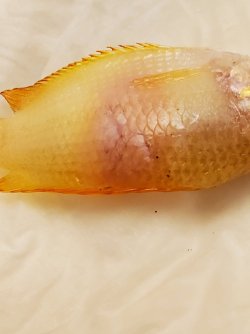Gemtrox42
Fish Fanatic
Tl;dr - Is it possible for Honeys to get DGD? Does the attached image accurately represent DGD?
Over the past few months, I've been buying Honeys and "Red Honey" gourami from my LFS. I wanted to buy Dwarfs originally but I was warned off by users here (thanks!) due to the prevalence of DGD. The problem is, my Red Honeys all drop dead approximately a month after purchase. All of them followed a similar pattern - they'd be introduced to the tank, would pace around the glass but otherwise appear fine, then starting anywhere from a week to 3 weeks in things would go bad. The first thing I'd notice was a dramatic loss of color, then the pacing would be replaced by slow movements and lower appetite. Then, they'd sit still for long periods of time on the surface or the bottom, only moving when it was feeding time. In the final stages they'd barely be able to leave the bottom, and their bodies would be contorted. As soon as they started looking like that I'd euthanize them, otherwise at that point they die in about 24 hours. Unfortunately I can't remember if any of my regular Honeys died in a similar way. I had at least 3, maybe 4, one of which I returned for being a bully, and one that I euthanized after he started having what I assume is internal bleeding. The other two I've forgotten.
So during my research to find out what was wrong, I saw a picture of DGD that looks exactly like what I'd been experiencing. I don't have any of mine, but the attached image is exactly the same thing I've seen. So now I have a few questions. Is it possible for Honeys to get DGD? And does what I saw sound like DGD? If so, I believe my LFS sold me mislabeled fish, or purchased misidentified fish from a supplier. I'd like to know these things before I go request a refund. This goes without saying, but I don't think I'm going to be touching Honeys or Dwarfs again.
Bonus if you are Feeling Helpful: I've attached some pictures pre and post-mortem if anyone wants to offer input on the cause of my Honey's internal bleeding, I have no idea what happened and it still worries me.
Over the past few months, I've been buying Honeys and "Red Honey" gourami from my LFS. I wanted to buy Dwarfs originally but I was warned off by users here (thanks!) due to the prevalence of DGD. The problem is, my Red Honeys all drop dead approximately a month after purchase. All of them followed a similar pattern - they'd be introduced to the tank, would pace around the glass but otherwise appear fine, then starting anywhere from a week to 3 weeks in things would go bad. The first thing I'd notice was a dramatic loss of color, then the pacing would be replaced by slow movements and lower appetite. Then, they'd sit still for long periods of time on the surface or the bottom, only moving when it was feeding time. In the final stages they'd barely be able to leave the bottom, and their bodies would be contorted. As soon as they started looking like that I'd euthanize them, otherwise at that point they die in about 24 hours. Unfortunately I can't remember if any of my regular Honeys died in a similar way. I had at least 3, maybe 4, one of which I returned for being a bully, and one that I euthanized after he started having what I assume is internal bleeding. The other two I've forgotten.
So during my research to find out what was wrong, I saw a picture of DGD that looks exactly like what I'd been experiencing. I don't have any of mine, but the attached image is exactly the same thing I've seen. So now I have a few questions. Is it possible for Honeys to get DGD? And does what I saw sound like DGD? If so, I believe my LFS sold me mislabeled fish, or purchased misidentified fish from a supplier. I'd like to know these things before I go request a refund. This goes without saying, but I don't think I'm going to be touching Honeys or Dwarfs again.
Bonus if you are Feeling Helpful: I've attached some pictures pre and post-mortem if anyone wants to offer input on the cause of my Honey's internal bleeding, I have no idea what happened and it still worries me.
Attachments
-
 Dwarf-Gourami-Disease-Guide.png139.6 KB · Views: 241
Dwarf-Gourami-Disease-Guide.png139.6 KB · Views: 241 -
 20211109_202640.jpg142.5 KB · Views: 159
20211109_202640.jpg142.5 KB · Views: 159 -
 20211109_202614.jpg124.8 KB · Views: 160
20211109_202614.jpg124.8 KB · Views: 160 -
 20211109_172720.jpg118.1 KB · Views: 132
20211109_172720.jpg118.1 KB · Views: 132 -
 20211109_202625.jpg169.9 KB · Views: 133
20211109_202625.jpg169.9 KB · Views: 133 -
 20211109_172632.jpg181.5 KB · Views: 124
20211109_172632.jpg181.5 KB · Views: 124 -
 20211109_172640.jpg187.3 KB · Views: 137
20211109_172640.jpg187.3 KB · Views: 137
Last edited:

